10 things you should be cleaning with baking soda for better results
Our resident home and interiors expert has tried and tested the best things to clean with baking soda around the home


Cleaning with baking soda has become a go-to method for all manner of tasks, but it isn’t a fad – this is one small part of a cleaning revolution.
Like many, I wrongly believed that so-called ‘green-cleaning’ or eco-friendly cleaning was a lovely idea but only suitable for light work and that the really big cleaning jobs called for specifically developed super-strength chemicals.
After learning how to clean an oven with baking soda, I witnessed first-hand the tremendous cleaning power of baking soda and had to throw this notion in the bin (along with half the contents in my cleaning cupboard!).
Buoyed by the success of my foray into green cleaning and armed with my now trusty jar of baking soda, I set about re-learning how to deep clean your house without chemicals and the results might just surprise you...
Cleaning with baking soda: tried & tested by us
You might know baking soda by one of its alternate names, bicarbonate of soda or its chemical name - sodium bicarbonate (NaHCO3). Regardless of the name you use, you’ll be awed by its ability to cut through grease and grime and get your home sparkling clean.
Modern-day cleaning is markedly different to the days of old, gone are the copious amounts of harsh (often toxic) chemicals splashed around at every opportunity, replaced instead by a more sustainable living choice and considered approach to the products used and their effects on the environment.
Eco-savvy shoppers want less plastic waste, fewer pollutants in the waterways and fewer health-impacting chemicals in their homes and it’s easy to see why cleaning with baking soda and cleaning with vinegar are such winning formulas.
Sign up to our free daily email for the latest royal and entertainment news, interesting opinion, expert advice on styling and beauty trends, and no-nonsense guides to the health and wellness questions you want answered.
Here is what I recommend cleaning with baking soda, to guarantee sparkling results every time...
1. Give your oven a new lease of life

Cleaning an oven with baking soda is seriously satisfying. As you can see from the before and after pictures, the results were impressive, and the baking soda cut through layers of burnt-on grease.
To recreate this oven-reviving magic, you’ll need to make a paste of baking soda and water and allow to paste to soak in for a while.
Once fully soaked, harness the slightly abrasive texture of the paste and work it into the really tough areas. Finally, remove the paste with a wet sponge and dissolve any residue with a quick spray of white vinegar. Super effective but kind to the environment too, and you don’t have to deal with any nasty fumes next time you use your oven as is often the case with the chemical cleaning kits.
2. Clean oven trays with baking soda
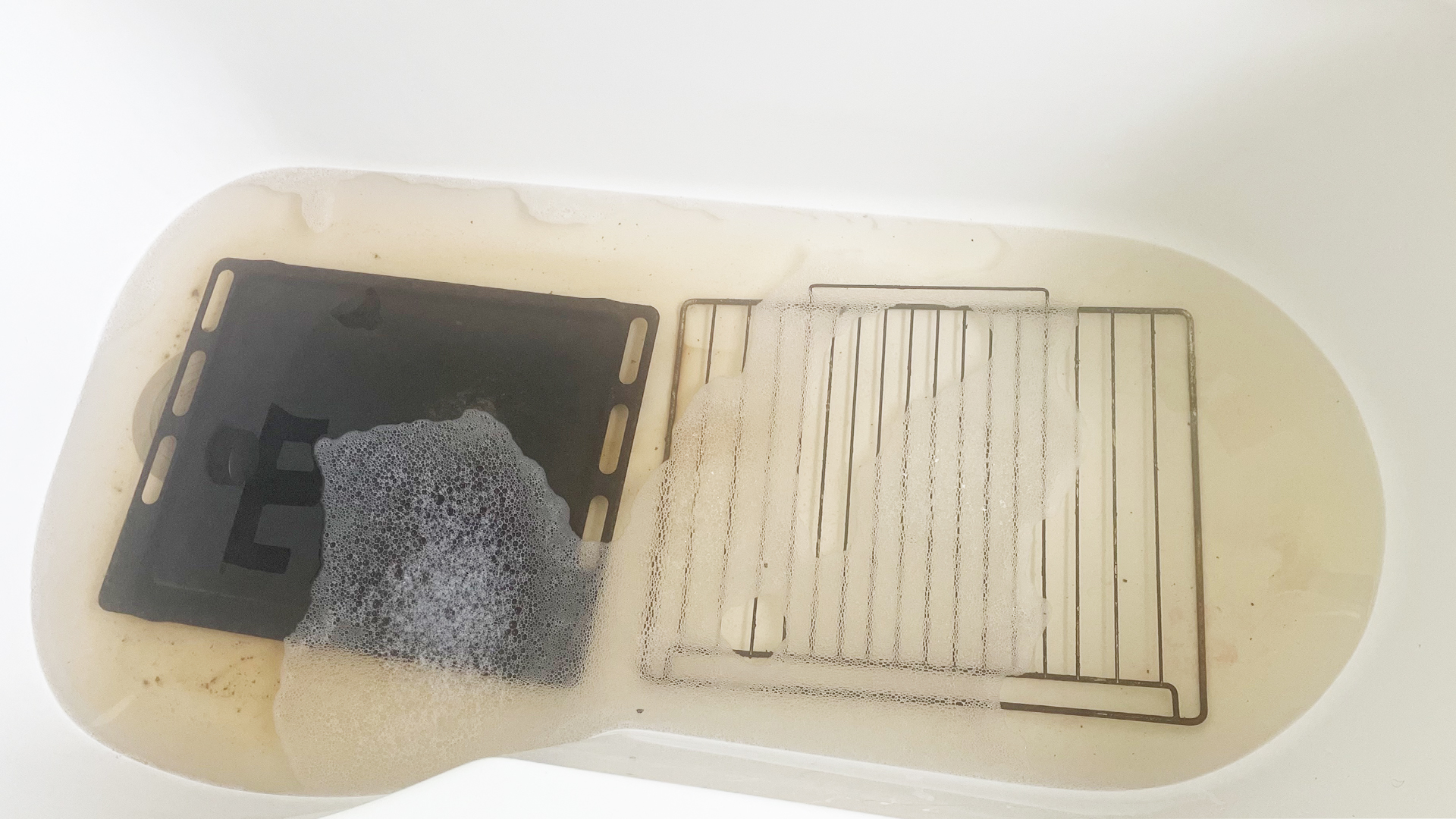
Discovering how to clean oven trays with baking soda has been a revelation.
Does this sound at all familiar? Spend ages cooking a lovely meal, enjoy eating the afore-mentioned lovely meal, return to the kitchen a while later and discover the anything-but-lovely baking trays in the oven or sink and immediately wish you’d ordered a takeaway.
Cleaning with baking soda, I have discovered, is the simple solution to this irksome task. Simply scrape out the trays and sprinkle them with baking soda before adding some very hot water and allowing them to soak.
You’ll be surprised how easily the trays can be wiped clean after a good soak and returned to their former glory. If your sink is small, consider placing the baking trays in the bath to make the soaking process easier. The only problem is you’ll need a new reason to order takeaways.
3. Get sink plugholes shining again
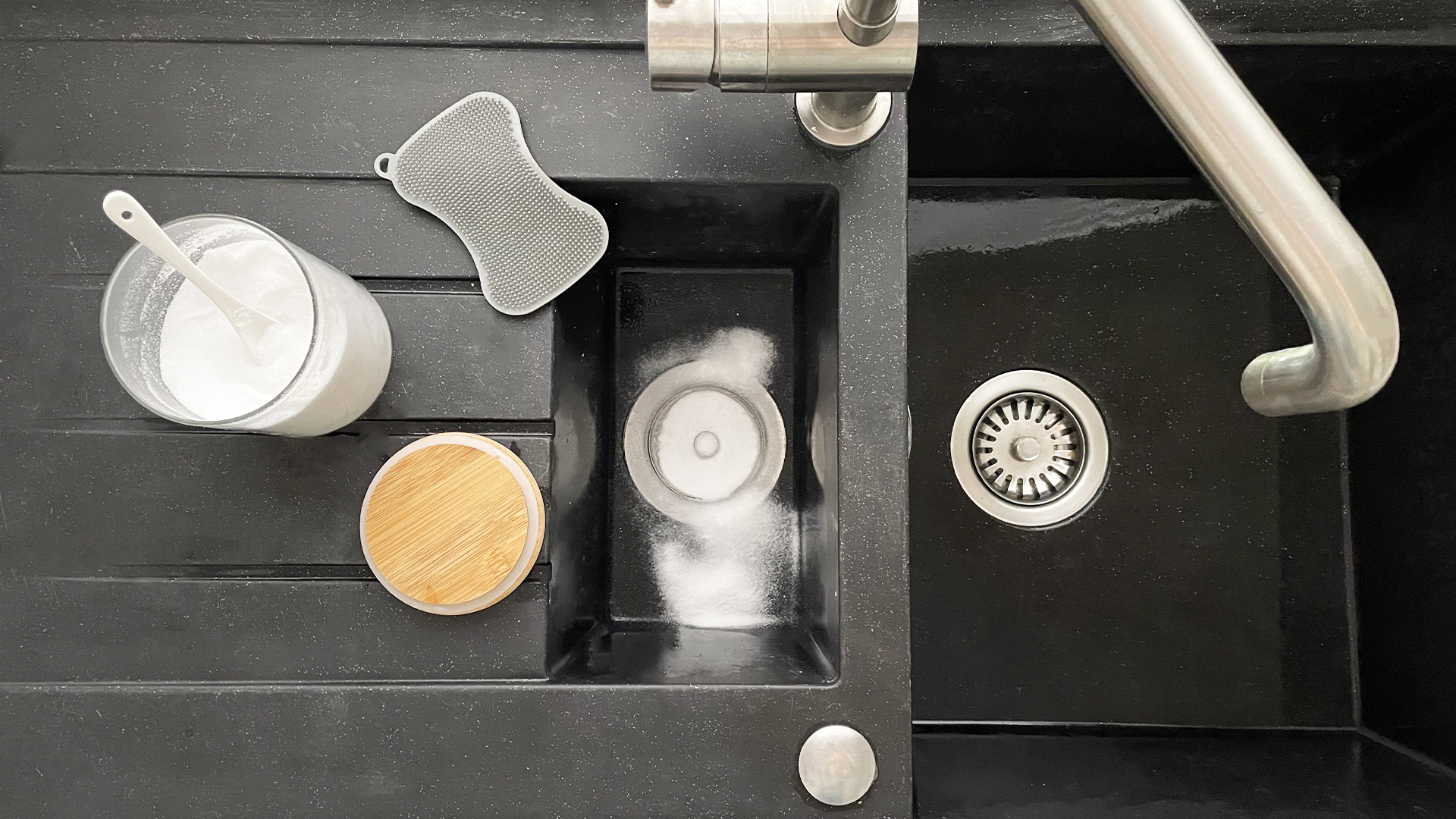
Cleaning stainless steel plugholes in the sink is an often neglected task. Possibly because they are hidden below sightline when surveying the kitchen for cleanliness, or possibly because it’s a tedious and often revolting job.
Here’s the good news, it’s quick and easy now, all thanks to cleaning with baking soda – a handy cleaning hack that actually works.
Simply pour make a paste with some baking soda and water, apply to the plughole area and allow to soak. After 30-60 minutes (depending on how stained or grimy the plughole is) use a sponge or gentle (non-abrasive) scouring pad and rub the paste away to reveal clean and sparkling plug holes.
You can pour a little white vinegar onto the plughole before running the tap for a satisfying fizz. Rinse the rest of the paste down the drain by running the hot tap and this will help clean the waste pipe under the plughole too.
4. Clean a washing machine with baking soda

It’s a well-known fact that in order to do the best job, your cleaning appliances must be well-maintained. Thanks to my new-found love of cleaning with baking soda, I’ve discovered how to clean a washing machine without chemicals for optimum results and it’s super easy.
Simply pour a couple of scoops of baking soda into the drum along with a couple of caps of white vinegar before running a hot wash this will help get rid of bacteria and any unpleasant smells. I use a paste of baking soda and water to clean the removable detergent drawer before rinsing it with hot water and white vinegar.
Side note, white vinegar also holds the secret to how experts soften towels – who knew?
5. Remove grease stains from a carpet
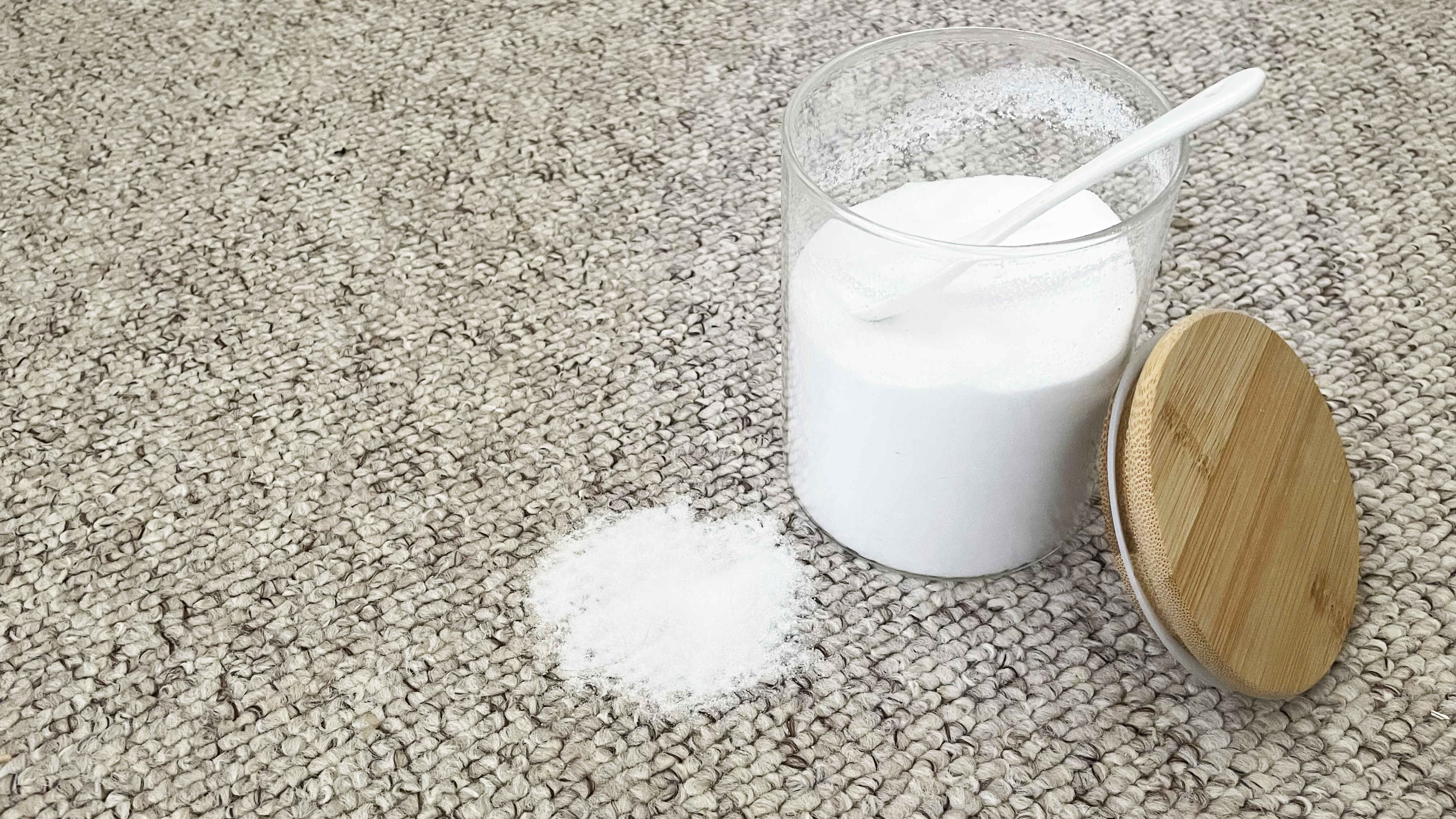
I’ve discovered that cleaning with baking soda is the perfect way to remove grease stains from carpet and it’s super simple to do. Sprinkle baking soda over the affected area of the carpet and lightly spray it with water using a plant mister until damp.
Leave the damp baking soda to dry out completely and vacuum once dry. Repeat if the stain persists.
6. Keep a fridge smelling fresh
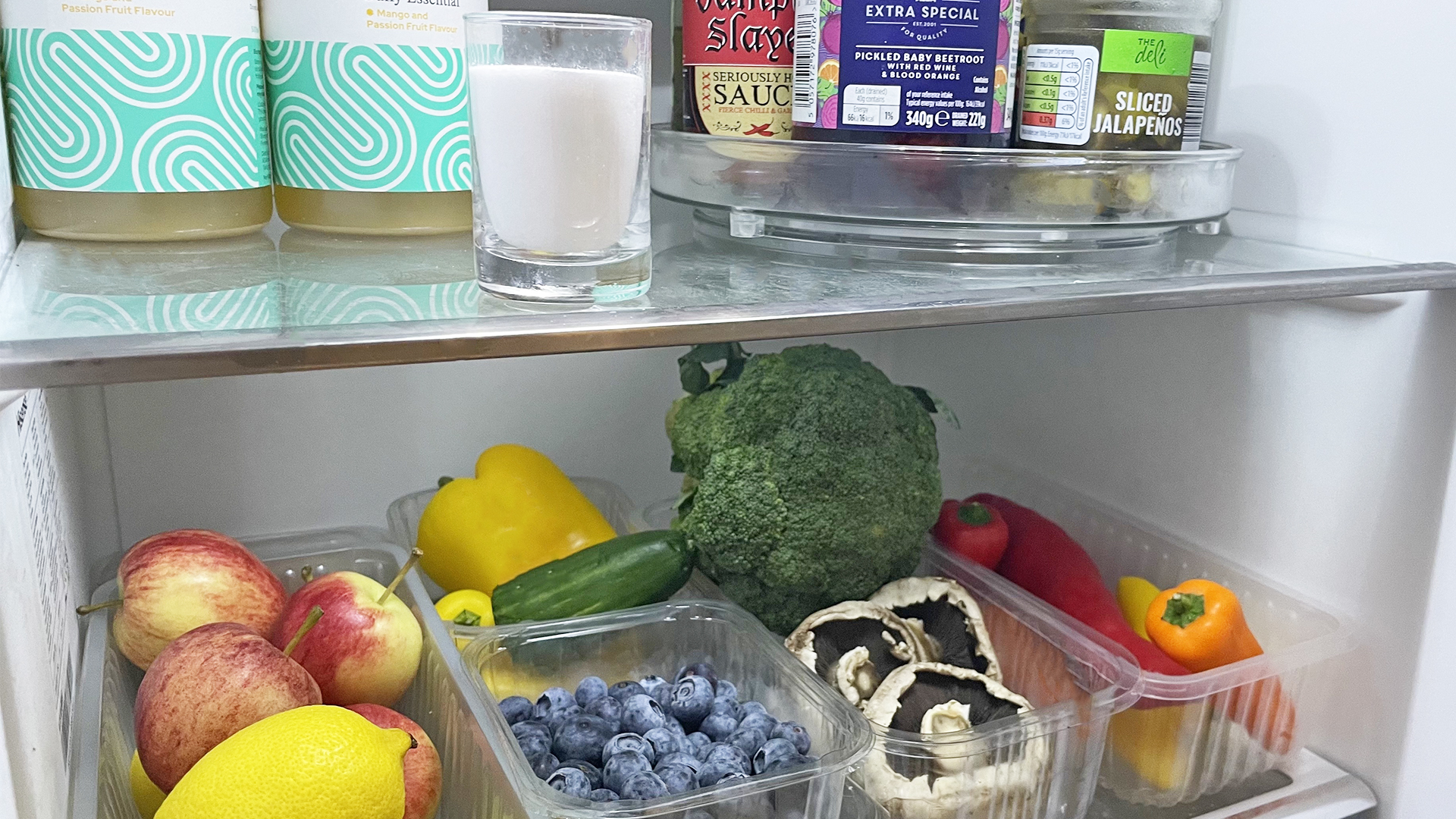
Removal of unwanted smells from the air was an unexpected benefit of cleaning with baking soda and works a treat in the fridge. Simply leave a small cup of baking soda on a shelf and it will absorb strong odours or unwanted smells.
This strategy works especially well if you keep eggs in the fridge as their porous shells can absorb strong odours, just place the cup close to the eggs for worry-free storage. This is a great final step in the process of how to clean a fridge and make your house smell good on a budget.
7. Remove heavy stains from the base of pots or pans
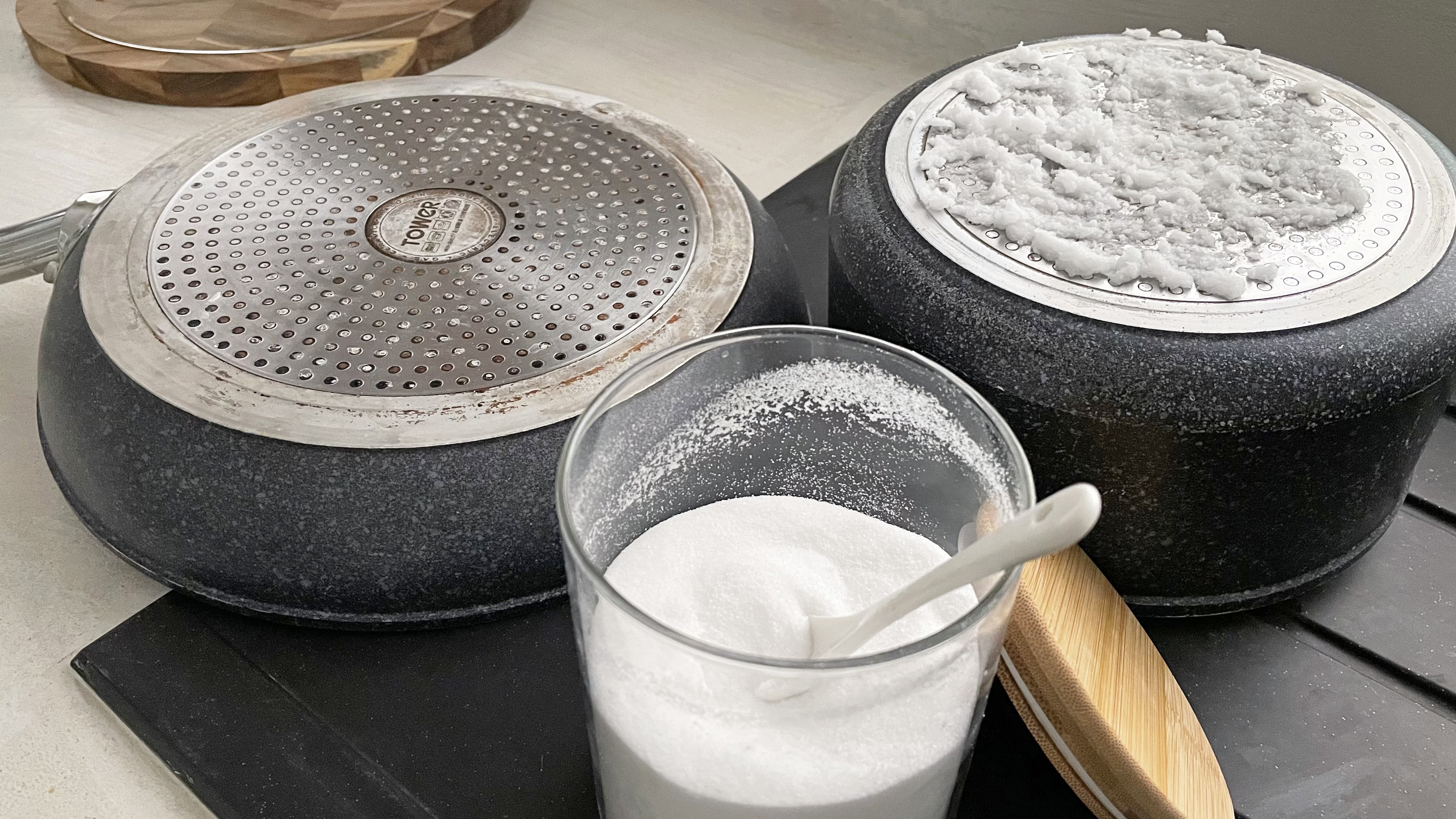
Pots and pans accumulate burnt cooking residue and grease as well as scorch marks and can look unattractive in no time unless you give them a regular clean. The good news is that cleaning with baking soda will restore your best stainless steel pans to their former glory in no time.
I’ve found the best method to clean a burnt pan is to sprinkle baking soda over the base of the pan and add a little white vinegar, rub the fizzing mixture into the pan base (I find an old toothbrush convenient for this task) and leave it to soak.
After about 10 minutes pour more white vinegar over the pan to neutralise any remaining baking soda and rinse with clean water to reveal a sparkling clean stainless steel pan base.
8. Clean a dishwasher with baking soda

Dishwashers deal with dirty crockery and cutlery every day, so it’s easy to see why they need regular cleaning. Steer clear of harsh chemical dishwasher cleaners, as baking soda is the magic ingredient that will make your dishwasher’s day. Not only is baking soda free from harsh chemicals it is cost-effective and readily available - win, win.
To clean your dishwasher, sprinkle a generous amount of baking soda into the base of the empty appliance. Remove the filter and give it a good rinse before replacing it and setting the dishwasher on a hot cleaning cycle.
Leave the dishwasher door open once the cleaning cycle has completed to prevent unpleasant smells from occurring, and be sure to repeat this super simple process regularly. Check the dishwasher salt levels and top up if required, as this will help your dishwasher produce the best results.
9. Remove hard water marks from a toilet

Cleaning toilets is arguably one of the worst housekeeping tasks. This job is made extra unpleasant if you live in an area with very hard water as hard water stains will accumulate on a toilet regardless of whether it is in use making regular cleaning all the more important.
Happily, there is a quick, easy and effective solution to this undesirable issue, and you’ve guessed it… cleaning with baking soda is the best way to clean a toilet.
Sprinkle baking soda liberally into the toilet bowl and pour some white vinegar over the top (use 1 cup baking soda to 2 cups of vinegar as a rough guide) allow the mixture to fizz as it reacts together, then spread the mixture around the bowl with your toilet brush ensuring all affected areas are covered.
Leave the fizzing mixture for approximately 10 minutes, then use the toilet brush to scrub the bowl. You’ll be surprised at how easily the marks and hard water stains lift, leaving a sparkling bowl behind. Flush the toilet and admire your newly cleaned toilet, note to self, don’t leave it so long next time.
10. Clean a hob/stovetop and remove burnt-on stains

This handy hack worked a treat on my glass hob and made light work of removing the burnt-on cooking residue after a pan had boiled over. Here's the best way to clean a stovetop with baking soda. After making a paste of baking soda and water and applying it to all the affected areas, it was time to wait, allowing it to soak in.
After about 30 minutes, the burnt-on residue should lift quite easily with a mild scouring pad or sponge. Wipe off any remaining baking soda paste and rinse with warm water or a quick spray of white vinegar for a perfect sparkling shine. Do not attempt this method if you have an induction hob.
What can I clean with baking soda?
There are fixtures, fittings, utensils and appliances in every room around the home that will benefit from cleaning with baking soda. Cleaning kitchens and cleaning bathrooms are the best places to start as they accumulate grease and grime that baking soda can easily cut through.
Hobs, ovens and microwaves can all be revived and restored to the cleanest with a combination of baking soda and elbow grease. Bathroom sinks, baths, toilets and showers are all great places to sprinkle that magic baking soda and bring back the sparkling shine.
Can you mix baking soda and vinegar to clean?
You can mix baking soda and vinegar to clean, but it’s worth noting that the fizzing reaction that occurs when the two mixtures are combined is the baking soda being neutralised. So to optimise the alkaline properties of the baking soda, to cut through grease, for example, it’s best to make a paste of water and baking soda and allow to soak for a while before cleaning up with white vinegar.
Is baking soda the same as bicarbonate of soda for cleaning?
Yes, bicarbonate of soda is the same as baking soda, they are alternate names for the same chemical compound, sodium bicarbonate (NaHCO3). Not to be confused with soda crystals aka Sodium carbonate, which are more alkaline and in crystal form rather than powder. Soda crystals are more abrasive.

Claire is a DIY and home interior writer specializing in budget room transformations, creative DIY projects, and resourceful home styling. Claire runs the popular home interiors blog ClaireDouglasStyling and shares all her DIY tips, tricks, and behind-the-scenes styling insights on her Instagram and Tiktok accounts. When she's not writing, Claire enjoys foraging for flowers and foliage and experimenting with interesting materials and decorating techniques to incorporate into future interior schemes; micro cement and postal tubes were a recent unusual but triumphant pairing. In her spare time, Claire enjoys creating floral installations for her home...the more bonkers the better!